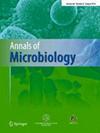从不同水源中分离大肠杆菌并确定其特征,将其生物控制应用与电子束辐照相结合以消除生活废水中的大肠杆菌
IF 3.4
4区 生物学
Q2 BIOTECHNOLOGY & APPLIED MICROBIOLOGY
引用次数: 0
摘要
包括大肠杆菌在内的抗生素耐药细菌是高风险的水传播病原体,对公众健康构成严重威胁。因此,本研究旨在开发经济实惠的替代处理方法。Coliphage 处理是一种经济上和环境上可持续的消除病原菌的方法。将大肠杆菌噬菌体与电子束处理相结合可能是提高杀菌效果的重要一步。十二种分离的大肠杆菌被用作宿主细菌。此外,还分离并鉴定了 11 种肠道病毒,以确定它们的适宜宿主范围和杀菌活性。抗生素耐药性测试检测了耐药性最强的大肠杆菌分离物。结果表明,大肠杆菌-2 和大肠杆菌-10 是耐药性最强的细菌分离物。体细胞噬菌体-3(S3)和 F 特异性噬菌体-3(F3)是最活跃的溶解性噬菌体。根据透射电子显微镜分析,S3 被归类为 Myoviridae 科,而 F3 则属于 Leviviridae 科。检测到的基因组类型为:S3 基因组为线性双链 DNA 病毒,而 F3 基因组为单链 RNA 病毒。将 pH 值调至 7 和温度调至 38 °C,S3 和 F3 的大肠杆菌活性分别提高了 32.2% 和 14%。S3 的最佳感染倍数(MOI)为 1:1,F3 为 2:1。根据一步生长曲线,估计 S3 和 F3 的潜伏期分别为 30 分钟和 20 分钟,猝灭大小分别为 5.8 和 4.6 (PFU)/感染细胞。计算了抗菌性最强的两种菌株(大肠杆菌-2 和大肠杆菌-10)的 D10 值,结果显示这两种菌株的 D10 值几乎相同(分别为 0.37 和 0.38 kGy)。这两种大肠杆菌噬菌体可单独使用,也可与电子束辐照(EBI)结合使用,以根除生活废水中最耐多药的大肠杆菌。电子束辐照使大肠杆菌-2 和-10 的数量分别减少了 59% 和 65%。而将大肠杆菌素和 EBI 结合使用,则可完全消灭这些微生物。将每种单独的大肠杆菌素与 EBI 结合使用,可将生活废水中大肠杆菌的生长降低到检测不到的水平。本文章由计算机程序翻译,如有差异,请以英文原文为准。
Isolation and characterization of coliphages from different water sources and their biocontrol application combined with electron beam irradiation for elimination of E. coli in domestic wastewater
Antibiotic-resistant bacteria, including Escherichia coli (E. coli), are high-risk waterborne pathogens that pose a vital threat to the general public’s health. Therefore, this study aims to develop alternative and affordable treatment approaches. Coliphage treatment is an economically and environmentally sustainable method for eliminating pathogenic bacteria. A significant step toward improving germicidal effectiveness might be to combine coliphage with electron beam treatment. Twelve isolated E. coli were used as host bacteria. In addition, eleven coliphages were isolated and characterized to determine their suitable host range and lytic activities. Antibiotic resistance was tested to detect the most antimicrobial-resistant E. coli isolates. Results indicated that E. coli-2 and E. coli-10 were the most resistant bacterial isolates. Both somatic coliphage-3 (S3) and F-specific coliphage-3 (F3) were the most active lytic coliphages. Based on transmission electron microscope analysis, S3 was classified as a member of the Myoviridae family, while F3 belonged to the Leviviridae family. Genome types were detected; the S3 genome was a linear double-stranded DNA virus, while the F3 genome was a single-strand RNA virus. The adjustment of pH to 7 and temperature to 38 °C increased coliphage activity by 32.2% for S3 and 14% for F3. The optimum multiplicity of infection (MOI) for S3 was 1:1 and 2:1 for F3. From the one-step growth curve, both the latent periods of S3 and F3 were estimated to be 30 and 20 min, and the burst sizes showed 5.8 and 4.6 (PFU)/infected cells, respectively. The D10 values of the most two antimicrobial-resistant strains (E. coli-2 and E. coli-10) were calculated, showing nearly identical values (0.37 and 0.38 kGy), respectively. Both coliphages were used, either alone or in combination with electron beam irradiation (EBI), to eradicate the most multidrug-resistant E. coli in domestic wastewater. EBI reduced the counts of E. coli-2 and -10 by 59% and 65%, respectively. While the combination of coliphages and EBI completely eradicated these microbes. Combination of each individual coliphage and EBI decreased the growth of E. coli in domestic wastewater to an undetectable level.
求助全文
通过发布文献求助,成功后即可免费获取论文全文。
去求助
来源期刊

Annals of Microbiology
生物-生物工程与应用微生物
CiteScore
6.40
自引率
0.00%
发文量
41
审稿时长
3.2 months
期刊介绍:
Annals of Microbiology covers these fields of fundamental and applied microbiology:
general, environmental, food, agricultural, industrial, ecology, soil, water, air and biodeterioration.
The journal’s scope does not include medical microbiology or phytopathological microbiology.
Papers reporting work on bacteria, fungi, microalgae, and bacteriophages are welcome.
Annals of Microbiology publishes Review Articles, Original Articles, Short Communications, and Editorials.
Originally founded as Annali Di Microbiologia Ed Enzimologia in 1940, Annals of Microbiology is an official journal of the University of Milan.
 求助内容:
求助内容: 应助结果提醒方式:
应助结果提醒方式:


